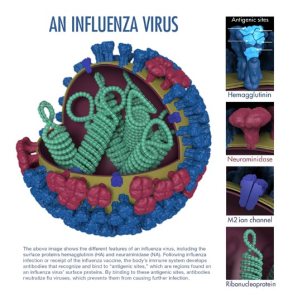In the tenth installment of the Immunology 101 Series, Aimee will explain the science behind the vaccines for influenza.
It’s that time of year again. You guessed it – time to get your annual flu shot! As an immunologist I relish this time of year. The flu shot lets me train my immune system to defend me against the flu virus. I must admit that I call my children’s pediatrician office every year in late August and sign up for the first flu shot clinic available. I make sure that my family will have an immune army built, trained, and ready to defend us long before influenza (aka ‘the flu’) makes it to Denver! I do this because I know that the vaccines for influenza are safe and effective and that illness from the flu is very serious and potentially deadly. As a scientist who has read the literature, I understand that the risk from the flu shot is minimal compared to the danger of becoming sick from the flu.
Most people I encounter who are skeptical about the flu vaccine have the same questions. They often wonder why we need to get a flu shot every year, if the flu shot can actually give you the flu (spoiler alert – no!), and if the flu is even really a serious disease (spoiler alert – yes!).
Why do I need a flu vaccine every year?
We need a flu shot every year because the strains of influenza that circulate the globe change every year.
Viruses have evolved this way in order to escape the immune systems of their hosts. Fortunately, we have figured out their tricks and have developed a way to defeat them – vaccines!
The easiest way to explain this trickery performed by viruses is to think about viruses as little, tiny chameleons who are very good at changing their appearance. Let’s pretend that each virus wears a coat (this is actually true, although we call it a capsid) and almost every time a new virus is made the coat changes color. As an example, let’s pretend that the first virus is wearing a red coat. The baby viruses (aka virions) that this red coat-wearing virus produces are orange. The virions that the orange coat-wearing virus produces are yellow, and so on (you get the idea). This is more or less what happens in real life. Each year the influenza virus changes its ‘coat’ and as a result we need to make a new vaccine that will allow us to build immune memory against the new forms of the flu virus. Thankfully, there are laboratories all across the globe that track the flu virus and communicate with vaccine manufacturers to produce flu vaccines that contain the most recent three to four strains of influenza.
The influenza ‘coat’ is made up of proteins called ‘H’ for hemagglutinin and ‘N’ for neuraminidase. This is why scientists call different flu strains ‘H1N1’ or ‘H3N2’ because we have numbered the different proteins for ‘H’ and ‘N’ and name the virus based on which ‘H’ and ‘N’ it is wearing that year.
To bring you back to understanding why we need to make a new vaccine and get a flu shot every year is that if our immune system built an army last year against the virus wearing a red coat, we would not be protected against the new strain(s) this year that are wearing blue and purple coats. We need to build immune protection against the new viruses that actually look different to the immune system.
Can I get the flu from the flu vaccine?
The short answer is ‘no,’ but let me explain with some detail to make sure you can clearly explain this important bit of information to your friends and family. Scientists and healthcare providers need all the help we can get when it comes to debunking this common misconception!
The influenza vaccine that is given in shot form contains a killed version of the flu virus. The killed version of the flu is not capable of infecting you or making you sick. It is actually impossible to get the flu from the flu shot. The most common response to the flu shot is redness and/or swelling at the site of injection, although other mild side effects can include fever, headache or muscle aches. Minor side effects are actually a good sign. The swelling and redness let you know that your immune system is responding by building an immune army against the flu that will be ready to fight in about two weeks. Remember, these minor side effects are minimal compared to the actual disease, which can cause serious complications (see below).
If a person does get the flu shortly after receiving a flu shot, it is likely that they were exposed to the flu virus before they got the vaccine or before the two week window that is needed for the immune system to build an army that is ready to defeat the flu. This is why healthcare professionals urge us to get the flu vaccine long before the flu appears.
What is the difference between the flu shot and the nasal spray vaccine?
As you may already know, when you go to your doctor’s office or a flu shot clinic, you are often offered a shot form or a nasal spray form of the flu vaccine. These two forms of the vaccine are made a little differently but both result in protection.
The flu shot, as mentioned above, is composed of flu virus that has been killed with a chemical. This form of the vaccine is recommended for anyone over the age of 6 months. The killed form of the virus is incapable of causing illness
The nasal spray form of the vaccine is alive but a severely weakened (otherwise known as ‘attenuated’) form of influenza. This form of the flu vaccine is recommended for healthy people between the ages of 2 and 49. This form of the flu vaccine is beneficial from the perspective of an immunologist because it allows your immune system to mount a response against a live virus that infects the nose. Because of this, the most common response to the nasal spray form of the flu vaccine is a runny nose. Many people, particularly children, prefer this form of the vaccine because they avoid getting a shot. Whichever you choose, it is important to understand that they are both completely safe and result in protection.
Why do people with egg allergies need to stick around their doctor’s office after vaccination?
The influenza virus has proven to be a little tricky to grow in culture. As a result scientists have found a way to grow influenza virus using hen eggs. Once the virus is grown in the eggs, it has to be purified to remove everything, like egg proteins, except the virus. This purification process works very well and people who have egg allergies and get the shot form of the vaccine should expect to have no allergic reaction. Sometimes when healthcare providers give the flu shot to people with egg allergies they ask them to stay at the clinic for 30 minutes just as a precaution to keep an eye on them for a possible, but unlikely, reaction. However, it is important to note that the nasal spray form of the flu vaccine is not recommended for people with egg allergies. If you or your child has an egg allergy you should ask your healthcare provider if the form of the flu vaccine you are receiving was made in eggs because very recently some manufacturers have made the vaccine using other (non-egg) methods.
Is the flu a serious disease?
The short answer is ‘yes,’ but let me explain in more detail. The influenza virus infects the cells of the respiratory tract (yes, the part of the body we use to breathe!). Symptoms often come on suddenly and include a high fever, muscle aches, headache, chills and often a runny nose and cough. Each year the flu virus kills thousands of people in the United States, particularly infants, elderly people and individuals with weakened immune systems (such as people with chronic infections or undergoing chemotherapy). However, healthy people with fully functioning immune systems also die from the flu each year. You could say that the flu is an equal opportunity pathogen – it will gladly attack the young, old, healthy or weak. It will take down anyone in its path who is not protected.
The moral of this blog story
Get the annual flu vaccine to protect yourself, your family, your friends, your neighbors, the people you see at the grocery store and the movie theater, the people you see on airplanes and in buses, the people you see at your kids’ soccer games or a Broncos football game – basically everyone you encounter. The flu vaccine is safe and will protect you and your loved ones from a very serious and potentially deadly infectious disease.
More resources:
- Flu.gov – Includes a flu vaccine clinic finder!
- Influenza: What You Should Know (PDF) – The Children’s Hospital of Philadelphia (CHOP) Vaccine Education Center
- Colorado Flu Reports and Data – Colorado Department of Public Health and Environment
- Top Ten Reasons to Get a Flu Shot – Team Vaccine
- Healthychildren.org 2014-2015 Flu Season – American Academy of Pediatrics
- Families Fighting Flu
- Immunize for Good


